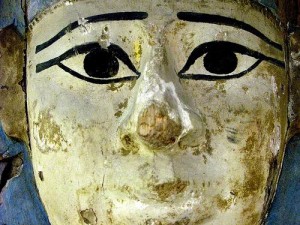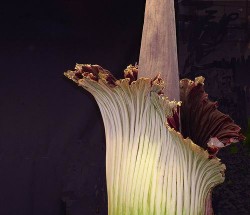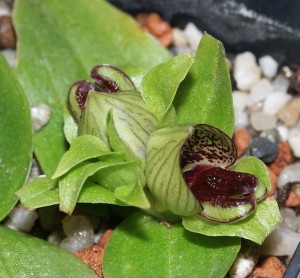 As someone who writes about archaeology, I often consider myself to be in the death business. I’ve grown accustomed to the company of skeletons and mummies, wrapped in their linen bandages, curled fetally under ancient house floors, or splayed in a tangle of bodies in a mass grave. Now, like a mortician, I take a kind of professional interest in the processes of death and decay. And this is why I was so intrigued recently by new research out of South Africa on an orchid, Satyrium pumilum. Its flower, reported the researchers, exactly mimics the odor of decomposition, specifically that of a decaying mammalian carcass.
As someone who writes about archaeology, I often consider myself to be in the death business. I’ve grown accustomed to the company of skeletons and mummies, wrapped in their linen bandages, curled fetally under ancient house floors, or splayed in a tangle of bodies in a mass grave. Now, like a mortician, I take a kind of professional interest in the processes of death and decay. And this is why I was so intrigued recently by new research out of South Africa on an orchid, Satyrium pumilum. Its flower, reported the researchers, exactly mimics the odor of decomposition, specifically that of a decaying mammalian carcass.
How odd, I thought. Why would any plant do that?
As it turns out, S. pumilum is not unique in this ability. Botanists have found more than 100 plant species that smell like decomposing fish, carrion or dung. The best known of this strange bunch is the corpse flower,  Amorphophallus titanum. As this plant prepares to bloom, it sends out a huge modified leaf sheathe with a reddish purple interior, a structure that resembles from the inside rippled slices of decaying meat. When the plant is ready for pollination, it warms the edges of this sheathe to an almost human body-temperature, and this volatizes its fetid scent. Carrion beetles and flesh flies that thrive on rotting protein find the corpse flower irresistible.
Amorphophallus titanum. As this plant prepares to bloom, it sends out a huge modified leaf sheathe with a reddish purple interior, a structure that resembles from the inside rippled slices of decaying meat. When the plant is ready for pollination, it warms the edges of this sheathe to an almost human body-temperature, and this volatizes its fetid scent. Carrion beetles and flesh flies that thrive on rotting protein find the corpse flower irresistible.
The little orchid S. pumilum lacks nectar and oil, two popular lures for insect pollinators. But the orchid family often makes up for what it lacks by deceit. One species, for example, emits chemicals mimicking a pheromone that females bees use to attract male bees. S. pumilum, however, has evolved a different strategy. It fakes the scent of death to attract a specific pollinator: the flesh fly. But just how closely does the faux odor match the real deal?
 University of KwaZulu-Natal botanist Timotheus van der Niet and his colleagues analyzed the orchid’s scent. The stench was dominated by three chemical compounds. The first, 2-heptamone, is known for its banana-like fruity odor. The second, p-cresol, is a prominent component in human sweat. And the third, indole, produces an intense fecal odor. Mixed together, they generate the reek of decay. Moreover, these same three compounds dominate the scent of a rotting mammalian carcass, the favorite fare of flesh-fly larvae.
University of KwaZulu-Natal botanist Timotheus van der Niet and his colleagues analyzed the orchid’s scent. The stench was dominated by three chemical compounds. The first, 2-heptamone, is known for its banana-like fruity odor. The second, p-cresol, is a prominent component in human sweat. And the third, indole, produces an intense fecal odor. Mixed together, they generate the reek of decay. Moreover, these same three compounds dominate the scent of a rotting mammalian carcass, the favorite fare of flesh-fly larvae.
How effective is this mimicry? Very. As one experiment conducted by van der Niet’s team showed, flesh flies couldn’t tell the difference between the stench of decaying roadkill and the fake scent produced by S. pumilum. So the little orchid enjoyed a relatively high rate of pollination: 31.5 percent. Its most frequent pollinators were female flesh-flies scouting about for a food source for the live larvae they carry.
Sex and death, death and sex, all in one hideous olfactory blast.
Top Photo. Wooden sarcophagus from Egypt, around 400 BCE, courtesy andrevanb. Middle Photo: Corpse flower, courtesy Slabcity Gang. Bottom Photo: Satyrium pumilum, courtesy of Bernd Haynold.
I love the biochemistry of nature! Thanks for this post, Heather!
Erika: I confess that that was exactly the part that got me interested in this story. Out of idle curiosity, I just started checking to see what each of the identified chemical compounds smelled like. There’s something sickly sweet about the smell of decomposition, and I now realize that it’s that fruity, banana accent note.
I’ll never look at a ripe banana the same way again…
Our neighborhood grow orchids. But I never knew they were associated with death. Chrysanthemums perhaps.